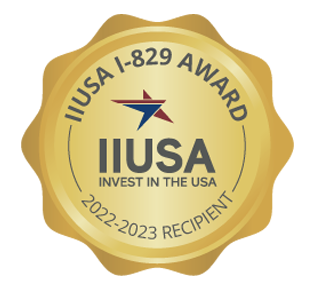Syndicated article. Original article published on StocksToday.com.
A Predictable Path to the U.S. Green Card
The EB-5 Visa program stands out in terms of predictability compared to other U.S. immigration options. Established to fuel economic growth while offering a direct route to permanent residency, EB-5 has gained traction among global investors seeking a reliable way to obtain Green Cards for themselves and their families.
The core of EB-5 mandates that investors make a significant capital investment in a qualifying U.S. business venture, leading to the creation of at least 10 American jobs. The minimum investment coupled with established eligibility criteria offers investors a straightforward roadmap to navigate the immigration process, which can take as little as five years.
EB-5 Visa & Financial Planning
Before embarking on the EB-5 Visa journey, prospective investors should engage in comprehensive financial planning to mitigate risk and optimize their investment strategy. In addition to the capital requirement, investors should consider accompanying fees, such as United States Citizenship & Immigration Service (USCIS) filing fees, U.S. immigration attorneys’ fees, EB-5 regional center project facilitation fees, and other associated costs (i.e., document translation). Investors should also carefully analyze potential U.S. tax implications arising from their EB-5 investment.
Minimum EB-5 Investment Amount
The minimum EB-5 investment amount is currently set at $1.05 million for standard investments or $800,000 for investments in Targeted Employment Areas (TEAs). The standard amount reflects the baseline capital required to support job creation and economic development in the United States. By contrast, investments made in TEAs, geographic areas designated with high unemployment rates or as rural, benefit from a reduced minimum threshold as well as priority processing to encourage investment in areas most in need of economic revitalization.
Fees Associated with the EB-5 Process
As mentioned, a number of fees accompany the EB-5 process and warrant investor attention. Immigration attorney fees constitute a significant but critical portion of these expenses, as legal expertise is essential for negotiating the sophisticated regulatory landscape of the EB-5 program.
Lawyers specializing in EB-5 help their clients from beginning to end. They prepare and submit documentation, represent investors throughout the adjudication process, and may also offer strategy formulation and due diligence services for potential investments.
Regional center fees represent another crucial aspect of EB-5 investment. Advantages of working with these intermediaries include offering investors a diverse range of pre-approved projects, reducing investors’ individual project management responsibilities, and increasing efficiency in the investment process. The regional center fee usually covers:
- Compliance and processing
- Fund preparation and operational costs (legal, accounting, administration, etc.)
- Fund administration setup
- Marketing and promotional costs
- Investor Know Your Client (KYC) compliance and due diligence
- IRS, SEC, and USCIS compliance
- Recordkeeping and reporting
EB-5 investors should also bear in mind USCIS application fees, including those associated with Form I-526 (Immigrant Petition by Alien Investor) and Form I-829 (Petition by Entrepreneur to Remove Conditions). Form I-526 seeks initial approval of investors’ immigrant petition based on their investment in a qualifying EB-5 project. The fee (shown below) covers the administrative costs associated with reviewing the investor’s eligibility and investment project’s viability. Subsequently, Form I-829 is filed to remove the conditions on the investor’s permanent residency status, typically within the two-year period following the approval of Form I-526. The fee is applied towards the cost of reviewing the investor’s compliance with the EB-5 program requirements, including job creation and sustainment of the investment throughout the conditional residency period.
USCIS Filing Fee Increases, Effective April 1, 2024
The federal government recently announced a significant increase in fees across various visa categories, effective April 1, 2024. Notably, the application for a conditional green card (Form I-526E) rose by 204%.
| Type of Filing | Current Fee | Increased Fee |
| Form I-526/526E – I-526/526E Immigrant petition by standalone/regional center | $3,675 | $11,160 |
| Form I-485 – Application to register permanent residence or adjust status (us-based applicants only) | $1,140 | $1,540 |
| Form I-829 – Petition by investor to remove conditions | $3,750 | $9,525 |
Source: https://www.uscis.gov/forms/filing-fees/frequently-asked-questions-on-the-uscis-fee-rule
Understanding the financial impact on applicants, Golden Gate Global, an award-winning EB-5 regional center headquartered in San Francisco, advised investors to submit their applications before the new fee structure takes effect, per its recent press release.
Golden Gate Global has raised over $700 million in EB-5 capital from more than 1,350 investors. The regional center prioritizes investors’ financial well-being by offering institutional-quality investment opportunities, experienced immigration professionals capable of addressing technical inquiries, and personalized guidance to ensure a smooth EB-5 process from start to finish. Therein, Abhinav Lohia, Managing Director of Global Business Development at Golden Gate Global, stressed the regional center’s commitment to supporting clients through USCIS fee increases by allowing investors to file their EB-5 applications with partial funding.
Conclusion
Meticulous financial planning is paramount for EB-5 investors embarking on the journey to obtain permanent residency in the United States. The intricacies of the EB-5 process necessitate a thorough understanding of the various fees, costs, and financial implications involved.
By conducting comprehensive financial planning upfront, investors can develop a strong understanding of EB-5, mitigate risks, and optimize their investment strategy. Forward planning also empowers investors to make informed decisions aligned with their immigration goals, ultimately increasing their chances of achieving permanent residency and realizing the American dream.
For more information on GGG and EB-5, please follow us on YouTube and LinkedIn.





